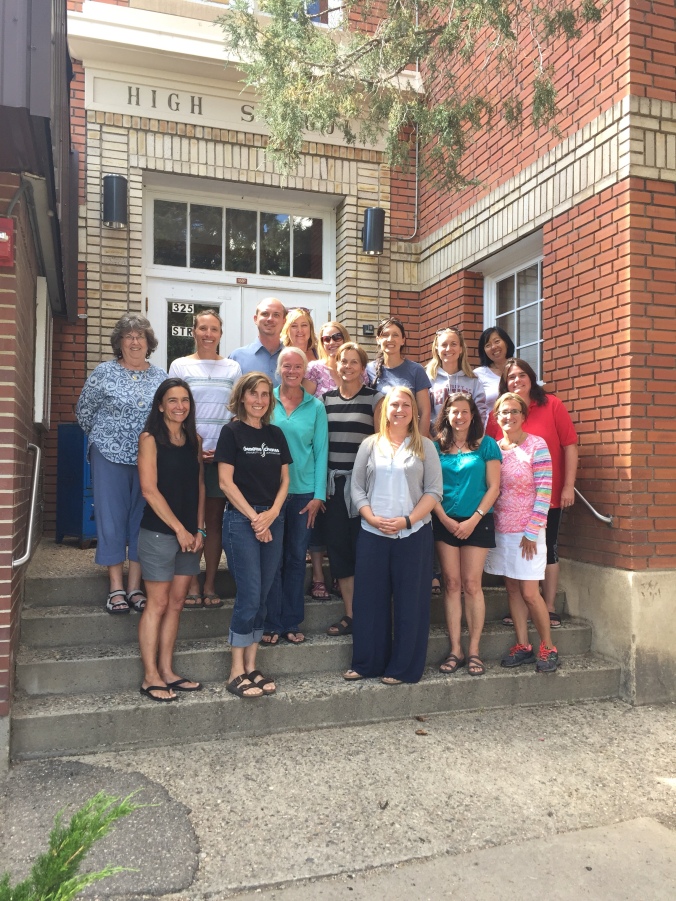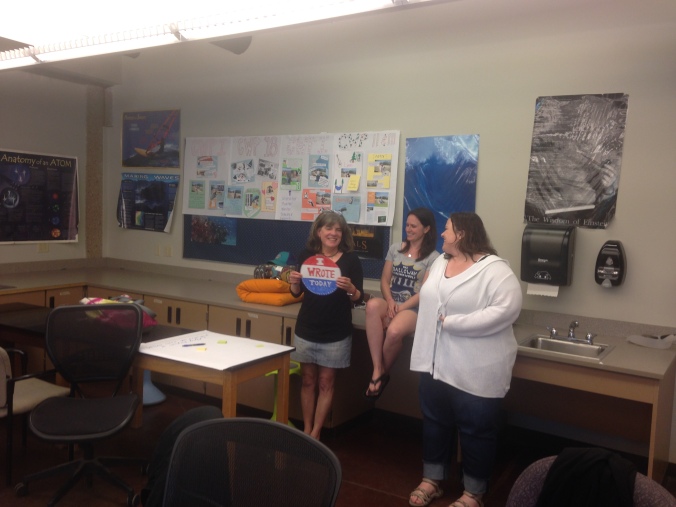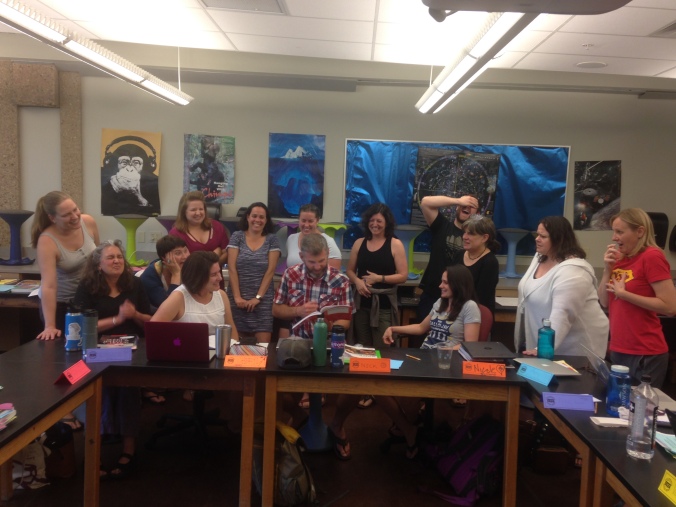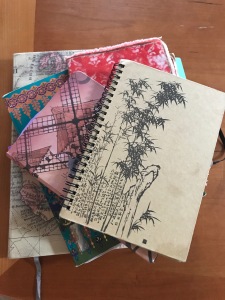Teachers from around the Denver area gathered in Adams 12 for two weeks of writing and learning

These teachers met in Steamboat this month for a two-day seminar focused on conferring with young writers.
Seminar in Steamboat on Conferring with Young Writers
Scenes from the CWP workshop going on in Boulder
CWP RETREAT APRIL 2018
Learning technology in Karen’s new kitchen.
Register Now for a Summer 2018 Workshop
Check out the Schedule/Registration page to see our 2-week workshops for this summer. We’ll add more sites as we get them set up. Register soon!
Need some inspiration? Read some testimonials.
Takeaways from Participants of CWP’s Session on Revision at CCIRA February 2018
- Take the time to share Golden Lines of student writing!
- I wish I knew why we write. I do not mean “authors” purpose. I mean this writing that digs into my heart. Is it an important part of the human experience? Can we get to the same stuff as oral processors? Percolating on these questions.
- I’m going to start writing – every single time my kids are writing.
- Thanks for the time to write! Today I realized I need to be my own writing teacher and encourage myself to do this — that I have ideas worth exploring and revising.
- *Golden line *Teacher revision – live! *Playing with writing, not fixing it.
- Courage comes first – to write to tell your story. Sharing makes us feel like writers. Then we are willing to revise.
- I love the idea of looking for the true heartbeat of a piece.
- This just adds to the plan I have after hearing Ralph Fletcher. This new Greenbelt Writing Project I’m going to start where I encourage students to defy genre with their writing.
- That revision does not have to be a difficult/teeth-pulling process! Revision helps empower writers.
- I am planning on exploring this idea of the heart of the writing. Loved this!
- There are so many things I’ve learned – is this method/idea the one thing I will have time to do?
- Give students the space to try.
- A good way to demonstrate the why of revision to students. Give them a real world example—not just some other task they have to do.
- A beautiful reminder that letting writers play as revisers builds courage and celebrates them as writers.
- I wish there had been an invitation to play. The writing and revising was the painful (traditional) way.
- My take away from this session has been the ability to fail on the first try but be given chances to improve upon it, learn from it, and know I’m not the only one. The “it” is writing.
- Revision doesn’t mean scrutiny. It means time to play – review, revise, re-see and spice things up!
- How do we get kiddos more time to passion write?
- Love the heart of the story. How to integrate specific writing skills with the greenbelt?
- Find time no matter what to allow kids to write about whatever they are passionate about. Give them courage to understand it’s a messy process.
- Sharing—reading your writing out loud is the key to revising.
- My take away is that revision is what all writers wrestle with as they polish.
- Georgia Heard’s Revision Toolkit has valuable questions that move away from basic questions to ones that dig deeper, yet are respectful of the writer.
- Writing with kids makes all the difference in the world.
- Revision is the love of writing.
- Write Your Way Out—what a great start to a quick write. I’m reminded that writing is a process that takes time—revision takes time and play.
- We must change the way we talk about revision. It is not a to-do list of doom but an opportunity to find your voice.
- I love the questions for peer conferring – revision questions that you ask the writer before they share their writing.
- I want to work to provide opportunities for my students to take ownership of their writing and feel that they truly are writers.
Thanks for joining us at CCIRA!
–Stevi and Karen
CWP Teacher/Consultant, Karen Crawford, retires after 30 years with the Colorado Writing Project
 Colorado Writing Project is sad to announce the retirement of our dear friend and colleague, Karen Crawford.
Colorado Writing Project is sad to announce the retirement of our dear friend and colleague, Karen Crawford.
Karen began working with CWP in 1987. For those 30 years, she has touched the lives of teachers throughout Colorado. Karen believes deeply in the power of writing and the importance of allowing students the freedom to write about what is important to them. Karen wrote for our website, “CWP fills my summer months in the company of teachers as students and teachers of writing, who often for the first time realize the power of the writer within and how that can transform their lives, their teaching lives, and the lives of their students.” Karen will be missed by all of her CWP colleagues and by the teachers she has worked with during her time as a CWP teacher/consultant.
Karen, I will especially miss your support, enthusiasm, and your positive vibes. You were always able to help me work through problems and keep me looking at the big picture. I know you will find lots of wonderful ways to fill up those summer months. Love you!
Karen Hartman
Karen Crawford was my mentor. We team-taught a CWP in Grand Junction one summer. Karen was up-beat, found the positive asepcts of each participant and their written work, and was unfailingly cheerful, even after staying up late to respond to papers! She was always thoughtful and deliberate in her written response to people’s writing and left the teachers with new energy for their work. During our annual retreats and attendance at state conferences, Karen provided encouragement and enthusiasm every day. Along with all these other qualities, Karen exemplified kindness and spread it around freely. She will be missed!!
Shari VanderVelde
Karen is a delightful, supportive colleague with a beautiful smile and a gentle wit. I loved teaching in Adams 12 with her one summer, and I marveled at her warm laughter, compassionate insights, and deep commitment to teaching writing as an authentic, relationship-based practice. When it comes to the best practices of writing instruction, she is a fierce defender of the true craft. I will miss seeing her at CWP retreats and at CLAS conferences, but I know she’ll be enjoying a joyful retirement life either traveling to beautiful places around the world or enjoying her lovely home in Colorado Springs with her beloved hummingbirds. I will miss you, Karen! Thanks for your amazing energy and caring, humane spirit!
Tim Hillmer
I first met Karen Crawford when I was new to the profession. We ended up on a team of 9th grade English teachers from across the state doing professional development, and I was immediately enamored of Karen’s sweetness and serene, earnest manner. She was a natural leader of our group, and she made us laugh with her at her funny observations, while also keeping us on track.
Years later, when I met Karen again, we were joined together by the Colorado Writing Project. Along with our amazing team of teacher consultants, Karen and I always shared a bunch of laughs as we planned our CWP workshops each spring. I also team taught one summer at Cherry Creek with Karen, staying at the same hotel and getting coffee every morning and dinner every evening. We reflected on our teaching and enjoyed planning and each other’s company. I know my teaching was enhanced that summer by all the conversation and collaboration I shared with Karen.
Karen’s legacy for me, among many other things, is that she reminds me of the importance of the soft skills and the special touches – in teaching and in life. From using pretty paper for responses to student writing to coffee mugs with special sayings to her tiny little home on her tiny little street, Karen Crawford has made a difference in my life.
Sheila Kaehny
I will miss Karen Crawford’s infectious energy. She leaves a considerable legacy through the Colorado Writing Project via all the teachers who were lucky to get to work with her. Her absence at the table during our annual CWP planning retreats will be palpable. She has been a source of encouragement and support for me in my work with teaching colleagues through CWP and in my own writing endeavors (thank you for the mug with the inspirational words that I put in front of me as I write). I’m sorry I never had the opportunity to co-teach a CWP workshop with Karen. I know it would have been memorable and that I would have learned so much from her.
Sarah M. Zerwin
It’s hard to imagine CWP without Karen Crawford. From the very start, she was by my side, first as a participant where we learned from the brilliance of Judy Gilbert and then as a teacher consultant. Her love of teaching, of the students and teachers she taught, and of powerful writing instruction was contagious and inspiring. A comment from a teacher this summer about Karen captures the impact she had on others. This teacher told me that Karen was her teacher consultant for CWP 1 and that each day was a love fest: for the community of writers, for the writing itself, for each individual. At the end of each day, this teacher hugged Karen as she left and since she wasn’t a hugger, she knew it was Karen’s care that created that need. So as Karen transitions to other endeavors in her life, she’s leaving behind many hugs and memories that matter for our kids.
Karen, here’s a hug from all of us to you.
Stevi Quate
Launching the Writer’s Notebook: Authenticity, Vision, Ownership
November last year I sat in a teacher’s classroom chatting about her hopes for the year. I looked around her room and saw a library filled with books that any middle schooler would want to read and commented on one of her walls, filled with photos of 6th graders at the local zoo and letters they had written to the newspaper and city commissioners about the horrible condition of the zoos.
“That was the best unit we did last year,” she explained. “Their passion, their work, their dedication impacted this city.”
Her cell phone rang and she excused herself to talk to a parent of a student new to her and invited me to look around the room.
This was a teacher whose work made a difference for kids and for the community. I knew that her classroom was one that I would want to linger in. Thinking about this, I glanced through Kai’s writer’s notebook and read his entry dated about a month earlier:
Ever since I was little I have wanted to be two things an engineer and a writer for a tv show. I always wanted to be the guy that was funny & was smart about how he was funny. I spent fourth and fifth grade learning about shows like “The Simpsons” or “Sienfeld” two very different shows but still very funny. I spent this time writing a show called “Grasious with other people’s money” & I made about 12 20 min episodes & my older brother said it was bad so I flushed it down the toilet, my dream with it.
And this was his last entry. The following pages were blank.
When she returned from the phone call, I asked her about Kai’s entry, and she admitted that she hadn’t read it. “I have the hardest time with writer’s notebooks. I know they’re important, but I just can’t figure out how to make them work especially with everything else that we have to do.” Her honest answer was one that I hear often from middle and high school teachers: the will is there but the skills for sustaining the writer’s notebook aren’t yet in place.
Authenticity
Lately I’ve been thinking a lot about this teacher and reflecting on why writers’ notebooks are so important to me. In fact, I can’t imagine teaching writing without that notebook. Why? Because I know that’s how I work and I know how valuable that notebook is to me.
What I wish I had asked that teacher is about hers. Does she keep one? When does she turn to it? How does she use it? Is the writer’s notebook (WNB) a part of her writing routine?
Here’s what I’ve come to learn: a teacher has to know from the inside out the value of a WNB. Keeping one has to be authentic, starting with the teacher herself. Without that insight, teachers have a hard time sustaining their students’ use of a WNB. Too often either the WNB fades after the first month or two of school or morphs into another school task: an assignment the teacher made, a commodity to be sold for the payment of a grade.
And here’s what else I’ve come to learn: launching the WNB matters. But launching means creating a vision for the power of a WNB and designing the work so that students have ownership in it.
Vision
I needed a vision for my WNB before I became ridiculously attached to it. For years I used my WNB as a journal, a place to keep notes from presentations and random thoughts on education. I called it my WNB but it was really more of a journal or a learning log, not a place that was the “junkyard of my mind” or a “compost heap” (Rosanna Warren) or “a place for seeds” (Ralph Fletcher). My use of a WNB began to shift when I started looking carefully at WNBs that others kept: Penny Kittle, Linda Rief, Don Murray (even though he called it a daybook). And then I started collecting quotes from writers about their WNBs:
- Into my notebook goes anything that is interesting enough to stop me in my tracks — the slump of a pair of shoulders in a crowd, a newspaper entry, a recipe, “chewy” words like ragamuffin. . . For me, it all begins with a notebook: it is the well I dip into for that first clear, cool drink. —Rita Dove
- The words do not take me to the reason I made the entry, but back to the felt experience, whatever it was . . . It is the instant I try to catch in the notebooks, not the comment, not the thought. —Mary Oliver
I started playing more with my WNB, adding photos I wanted to write about, trying a poem out, playing with colors, wishing that I could make mine as beautiful as Linda Rief’s.
 So what would I do to launch that writer’s notebook? First, I’d share several of my WNBs. I’d share several because each of my WNBs are a bit different. In my electronic notebook (yes, I have one of those), I have a section for collecting cool words and poems I love, but in my WNB from early this summer, I’ve played with sketch noting and added more heart maps. In my recent WNB, I’m playing with white space, thinking about how I can write sideways or create a concrete poem. I have entries about the passing of my dog: a poem, a Facebook entry, a vignette. Students would see how in some of my WNBs I’ve created indexes and divided my notebook into sections, using sticky notes to separate those sections: Here’s where I keep goofy words I’ve read, and here’s where I’ve copied down poems that I love and might emulate, and there’s where I’m keeping random thoughts about a topic I’m exploring. They would see that on the first page I’ve written myself a letter about my hopes and plans for this WNB, but this opening letter is a new routine for me.
So what would I do to launch that writer’s notebook? First, I’d share several of my WNBs. I’d share several because each of my WNBs are a bit different. In my electronic notebook (yes, I have one of those), I have a section for collecting cool words and poems I love, but in my WNB from early this summer, I’ve played with sketch noting and added more heart maps. In my recent WNB, I’m playing with white space, thinking about how I can write sideways or create a concrete poem. I have entries about the passing of my dog: a poem, a Facebook entry, a vignette. Students would see how in some of my WNBs I’ve created indexes and divided my notebook into sections, using sticky notes to separate those sections: Here’s where I keep goofy words I’ve read, and here’s where I’ve copied down poems that I love and might emulate, and there’s where I’m keeping random thoughts about a topic I’m exploring. They would see that on the first page I’ve written myself a letter about my hopes and plans for this WNB, but this opening letter is a new routine for me.
 I might also show a few entries in my WNB that were seeds that grew into future writing. I imagine that I might make a photocopy a few entries and then show how they turned up in Clock Watchers or Just Right Challenge or even in this blog. And why would I do that? To show how sometimes WNBs are storage units and sometimes they’re gardens where seeds are planted, as Ralph Fletcher states.
I might also show a few entries in my WNB that were seeds that grew into future writing. I imagine that I might make a photocopy a few entries and then show how they turned up in Clock Watchers or Just Right Challenge or even in this blog. And why would I do that? To show how sometimes WNBs are storage units and sometimes they’re gardens where seeds are planted, as Ralph Fletcher states.
But not only would I share mine, I’d share the journals of famous people along with their quotes. I imagine that I’d make a poster with excerpts from Ray Bradbury, Einstein, JR Rowling, some pop  musicians kids might know, and then I’d pepper the room with books like Steal Like an Artist and Joan Didion’s South and West. I want them to build a vision for the WNB that includes the myriad of ways that writers and thinkers use WNBs. I want them to know that the WMB is authentic – something that happens in the world outside of school.
musicians kids might know, and then I’d pepper the room with books like Steal Like an Artist and Joan Didion’s South and West. I want them to build a vision for the WNB that includes the myriad of ways that writers and thinkers use WNBs. I want them to know that the WMB is authentic – something that happens in the world outside of school.
Ownership
Too often – and lordy, was I guilty of this! – teachers co-opt WNBs – with the best of intentions. They become objects to meet the demands of assignments rather than a vehicle for a writer to play and take risks and gallop around with ideas galore. Teachers — again with the best of intentions — set up a section for vocabulary, for taking notes, for collecting grammar rules, for responding to prompts. They worry about accountability. But I want students to set up their WNBs in a way that works for them and to be accountable to themselves as evolving writers. I want them to own that WNB and to see that the WNB is much more than a task the leads to a grade. I want to show students like Kai how their WNB might be a place for them to study a genre, like he did as he studied The Simpsons and Seinfeld.
I think of Daniel Pink’s triad of elements that lead to motivation: autonomy, mastery, purpose. Those three elements need to be in place. Autonomy (or choice): a metaphorical room of my own (thanks Virginia Woolf!). No one assigned sketch noting to me, I got to decide. Purpose: No one told me my purpose. I got to discover it and then write about it in my opening letter to myself. Mastery: No one told me what I had master: I had my own purpose and knew that I could work to it.
Does that mean I wouldn’t assign quick writes or have students create heart maps or make lists of their writing territories (ala Nancie Atwell) or study and emulate craft? Oh, we’d definitely do all that, but I’d urge students to figure out what else they needed in order to grow as writers and then to set some goals. For instance, they might want to write daily outside of school for a month. Or they might want to analyze more craft in writing than what they’re doing in class. They might want to play around with different genres or include more art or make reading and writing connections. I want them to have ownership of the WNB.
And how would I know that they’re using their WNBs? Conferences. A routine for conferring with students during reading or writing workshop is to check with them about how the WNB influenced their reading, writing, thinking. When I confer, part of the conference would be to look through WNBs and to gently nudge through questions about how their current writing project was shaped by seeds planted in their WNB – a positive presupposition. Before a Socratic seminar, I’d ask how the WNB helped them prepared for the seminar.
To remind myself of the potential demise of the WNB, I’d tape this reminder from the Two Writing Teachers blog next to my computer and I’d use it in a whole class or small group discussion:
It’s a sad fact that our middle school “Lost and Found” bins seem to collect so many writer’s notebooks in particular. Whenever I leaf through these, I invariably discover that they are used mainly for note taking, with a few sketchy entries and a few responses to prompts. In elementary school, writer’s notebooks are introduced with much fanfare and joy, decorated with such celebration, and remain at the center of daily writing work. Something of this joy and purpose seems to get lost in middle school, just when most kids feel ready to explore deeper ideas and experiment with their writing voices.
I want students like Kai to keep thinking in the WNB: to take risks, to be vulnerable, to play. I don’t want blank pages following a few entries. WNBs are much too important to let them just gather dust on the shelves of our classrooms.














